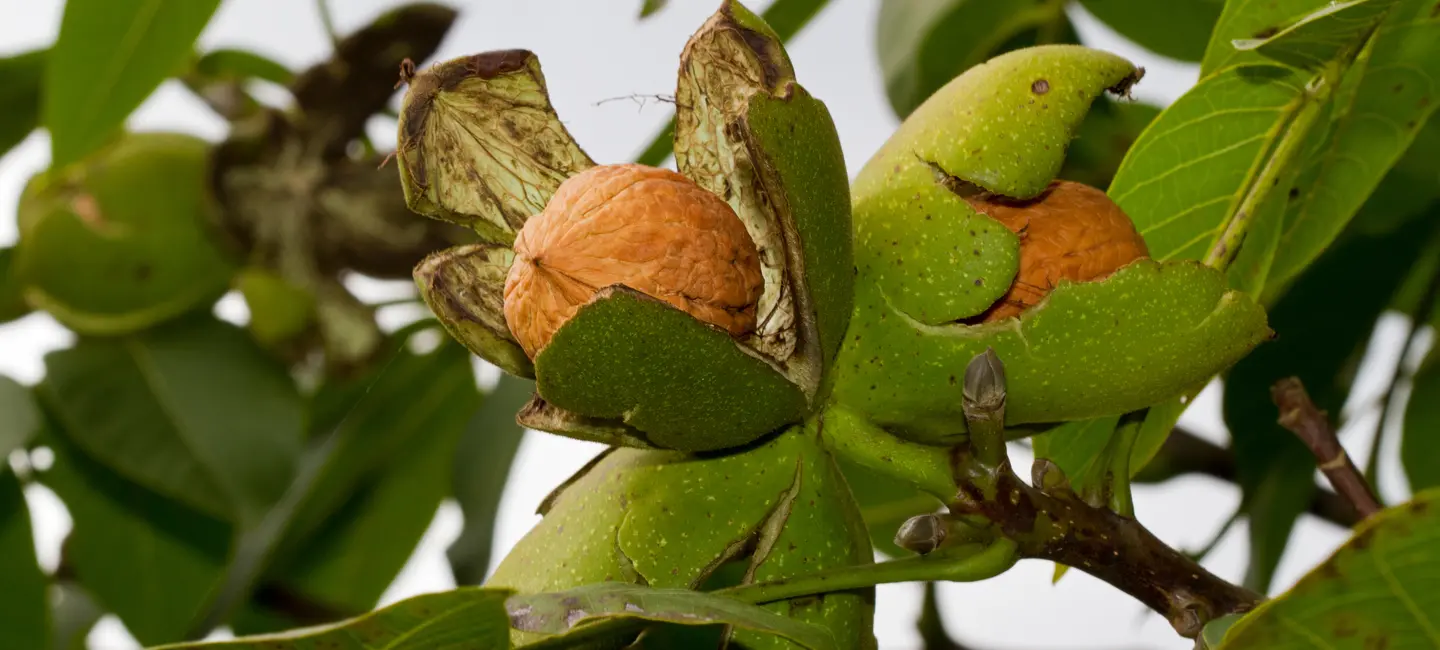
English walnut is a tree. The fruit (nut) is a popular food. The nut, the shell of the nut (hull), and the leaf are used to make medicine.
The nut is used as a part of the diet to lower cholesterol in people with high cholesterol. The nut, shell, and leaf are used for many other conditions, including diabetes, stomach problems, and skin conditions. But there is no good scientific research to support the use of English walnut for any of these other condiitons.
In foods, English walnut is commonly eaten as a snack, in baking, and in salads.
Is It Effective?
NatMed Pro rates effectiveness based on scientific evidence according to the following scale: Effective, Likely Effective, Possibly Effective, Possibly Ineffective, Likely Ineffective, Ineffective, and Insufficient Evidence to Rate.
- High cholesterol. Eating walnuts as part of a low-fat diet seems to lower cholesterol. Total cholesterol and "bad cholesterol" (LDL) are decreased when walnuts are eaten instead of fatty foods and account for up to 20% of the calories in the diet. Substituting walnuts for other dietary fats also seems to improve the ratio between "good cholesterol" (HDL cholesterol) and total cholesterol in people with type 2 diabetes.
- Heart disease. Eating 1.5 ounces of walnuts per day as part of a low-fat, low-cholesterol diet may help prevent heart disease. But research is limited.
- Diabetes. Some research suggests that taking English walnut leaf extract helps to lower blood sugar levels in people with diabetes, but other research does not agree. More research is needed.
- Acne.
- Anemia.
- Atopic dermatitis (eczema).
- Diarrhea.
- Infection of the intestines by parasites.
- Osteoarthritis.
- Swelling (inflammation) of the stomach (gastritis).
- Ulcers.
- Other conditions.
More evidence is needed to rate the effectiveness of English walnut for these uses.
Is it Safe?
The nut of the English walnut contains chemicals called fatty acids, which might be useful as part of a cholesterol-lowering diet. It also contains chemicals that can expand blood vessels, possibly improving circulation and the way the heart works. Some of these chemicals might also help with swelling, pain, and cancer.
When taken by mouth: The fruit (nut), shell, and leaf of English walnut are LIKELY SAFE for most people when eaten in usual food amounts. There isn't enough reliable information to know if the fruit or shell are safe in the larger amounts used as medicine. The leaf extract is POSSIBLY SAFE when taken at doses up to 200 mg daily for up to 3 months. The leaf extract can cause diarrhea. English walnut bark is POSSIBLY UNSAFE. Taking the bark daily might increase the risk for tongue or lip cancer.
When applied to the skin: English walnut bark is POSSIBLY UNSAFE. It contains a chemical called juglone that can irritate the skin.
Special Precautions & Warnings:
Pregnancy and breast-feeding: The fruit (nut), leaf, and shell of English walnut are LIKELY SAFE in food amounts. But there isn't enough information to know if these parts are safe in the larger amounts used as medicine. Stay on the safe side and stick to food amounts. English walnut bark is POSSIBLY UNSAFE. Don't take English walnut bark by mouth or apply it to the skin if you are pregnant or breastfeeding.
Allergies to peanuts and tree nuts: People with peanut allergies are more likely to be allergic to nuts called "tree nuts." English walnut is a tree nut. People who are allergic to one tree nut are also more likely to have an allergy to at least one other tree nut. Doctors often advise people with peanut allergies and tree nut allergies to avoid eating any tree nuts unless you know that you are not allergic to them.
It is not known if English Walnut interacts with any medicines. Before taking English Walnut, talk with your healthcare professional if you take any medications.
There are no known interactions with herbs and supplements.
There are no known interactions with foods.
The following doses have been studied in scientific research:
BY MOUTH:
- For high cholesterol: 8-11 English walnut nuts or 30-56 grams (about 1/4 to 1/2 cup) have been substituted for fats in the diet.
Akschota, Arbre au Sommeil, California Walnut, Coque de Noix, Feuille de Noyer Commun, Fructus Cortex, Gland Divin, Gland de Jupiter, He Tao, He Tao Shu Zhi, Hu Tao Ren, Juglans, Juglandis, Juglandis Folium, Juglans regia, Nogal, Nogal Inglés, Noix Anglaise, Noix de Grenoble, Noix Italienne, Noix Perse, Noyer Anglais, Noyer Commun, Noyer de Grenoble, Noyer Royal, Persian Walnut, Walnussblätter, Walnussfrüchtschalen, Walnut, Walnut Fruit, Walnut Hull, Walnut Leaf.
Information on this website is for informational use only and is not intended to replace professional medical advice, diagnosis, or treatment. While evidence-based, it is not guaranteed to be error-free and is not intended to meet any particular user’s needs or requirements or to cover all possible uses, safety concerns, interactions, outcomes, or adverse effects. Always check with your doctor or other medical professional before making healthcare decisions (including taking any medication) and do not delay or disregard seeking medical advice or treatment based on any information displayed on this website.
© TRC Healthcare 2024. All rights reserved. Use and/or distribution is permitted only pursuant to a valid license or other permission from TRC Healthcare.
